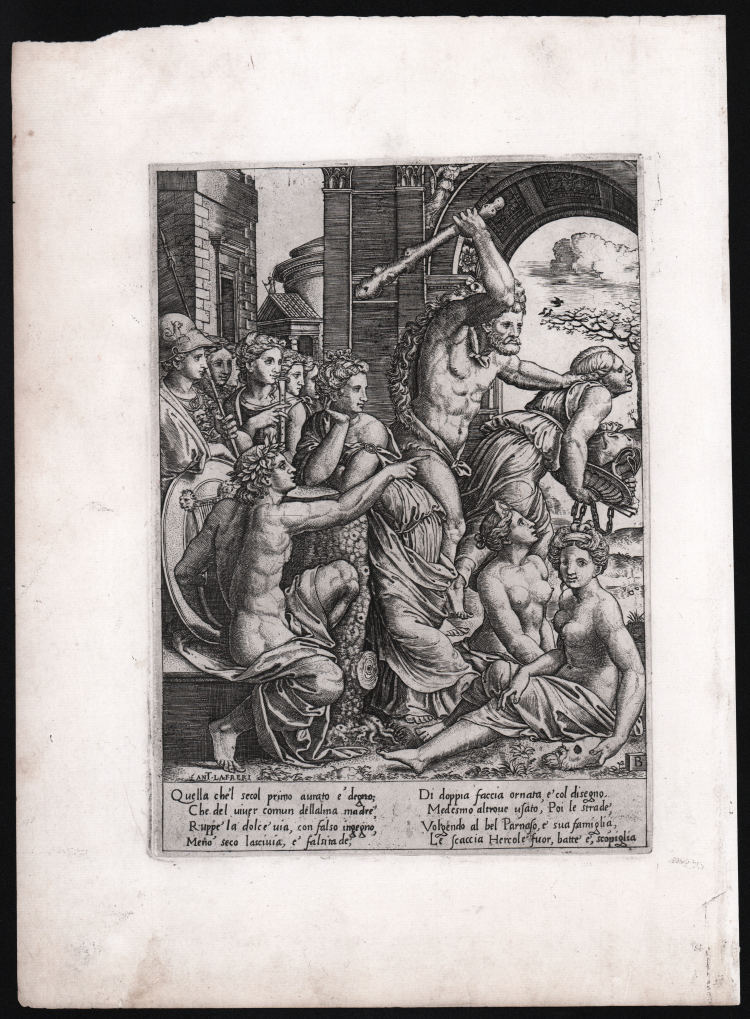





| Reference: | S48429 |
| Author | Maestro B nel Dado |
| Year: | 1530 ca. |
| Measures: | 185 x 260 mm |




| Reference: | S48429 |
| Author | Maestro B nel Dado |
| Year: | 1530 ca. |
| Measures: | 185 x 260 mm |
Avarice at the right being driven from the temple of the Muses by Hercules who raises a club in his right hand while the Muses look on.
After the chiaroscuro woodcut by Ugo da Carpi after Peruzzi (B.XII.133.12).
Engraving, circa 1530, lettered at lower left 'Ant.Lafreri' and artists monogram 'B' on dice at right, in bottom margin eight lines of description 'Quella che'l secol ... batte e scopiglia'.
Example from the second state of five, with Antonio Lafreri's address at lower left. This state is not described by Bartsch, who knows only of the later edition by publisher Philip Thomassin in which the name of Lafrery is replaced by 'Baltazar Perutius Senen. inventor'. The Lafreri edition is very rare; a 'specimen is preserved in the British Museum, while many of the museum collections possess the Thomassin edition. Later issues of the print signed De Rossi and Losi are also known.
In Renaissance Italy, artists, patrons and other educated people were fascinated by the tales of classical mythology, which were revived in new Latin editions as well as translations into the Italian. Frequently, the gods and heroes of the ancient texts were adapted to symbolic purposes to convey moral or political ideas. In this print Hercules, symbolizing virtuous strength, drives away Avarice—a woman holding a hoard of precious objects—from the temple of the arts. The traditional protectors of artistic pursuits, Apollo and Minerva, look on with satisfaction, surrounded by the Muses. The nine muses, of which eight are visible here, were also associated with learning, particularly with poetic inspiration. The message is that avarice undermines the cultivation of the arts.
“Nella donna che fugge dietro i violenti colpi inferti dalla nodosa clava di Ercole, le cui spalle sono ricoperte dalle spoglie del leone Nemeo, è riconoscibile l'Invidia; a sinistra Apollo seduto ordina al dio di scacciare la donna, dietro ad Apollo sono visibili le Muse e Minerva armata. Nella figura a destra riconosciamo la Lascivia e la Falsità che reca nella mano sinistra la maschera, simbolo di insicerità e falsità che nell'Iconologia del Ripa diverrà attributo della Bugia, Frode, Inganno (cfr. E. Panosfky, Studi di Iconologia, Torino, 1975, pp. 126 ss.). L'incisione deriva da un disegno, oggi disperso, di Baldassarre Peruzzi come si deduce dalla scritta che appare nell'edizione ritoccata da Philippe Thomassin che ha aggiunto al suo nome quello del senese. Ulteriore conferma deriva dal confronto con il chiaroscuro a due legni di Ugo da Carpi raffigurante lo stesso soggetto che reca la scritta dell'incisore: BAL. SEN., cioé il Peruzzi. Il soggetto del Peruzzi viene ricordato dal Vasari nella vita di Marcantonio Raimondi (ed. Milanesi, V, p. 422): "Perché dopo di lui [Ugo da Carpi il Baldassare Peruzzi, pittore senese, fece di chiaroscuro simile una carta di Ercole, che caccia l'Avarizia, carica di vasi d'oro e d'argento, dal Monte Parnaso, dove sono le Muse in diverse bella attitudini, che fu bellissima" (cfr. S. Massari, Tra Mito e Allegoria, p. 110).
A very good, uncut, impression on contemporary laid paper with “anvil and hammer in circle” watermark (Woodward nn. 230-232), with margins, perfect condition.
Bibliografia
Bartsch, Le Peintre graveur (XV.195.17); S. Massari, Tra Mito e Allegoria, pp. 110-111, n. 34 II/III; R. D'Amico, M. Tamassia, Incisori veneti dal 15. al 18. secolo, 116, p. 39; TIB 29 (15). 17(195) (Suzanne Boorsch [Ed.] 1982, “The Illustrated Bartsch: Italian Masters of the Sixteenth Century”, vol. 29, Abaris Books, New York, p.174).
Maestro B nel Dado (Attivo a Roma, metà XVI sec.)
|
Master del Dado was trained as painter and engraver in Marcantonio’s workshop; he was born around 1512 and worked in Rome between 1532 and 1550. He is very often mistaken with Beatricetto or Bonasone.
Le Blanc believes that he was a descendant of Bernardo Daddi (1512 – Rome 1570), a painter, according to the monogram that signs his prints. Some others identify him with Benedetto Verini, presumed son of Marcantonio, which would have explained the monogram BV on his plates. According to Bartsch though, the V might stand for Venetian or again for Tommaso Vincidor da Bologna.
He engraved drawings of other artists for Lafrery; his favourite subjects were Raphael, Peruzzi, Giulio Romano and Tommaso Vincidor.
To Master del Dado have been ascribed about 85 prints, according to Malaspina and also Bartsch says they are 85, while Passavant believes they are 89.
|
Maestro B nel Dado (Attivo a Roma, metà XVI sec.)
|
Master del Dado was trained as painter and engraver in Marcantonio’s workshop; he was born around 1512 and worked in Rome between 1532 and 1550. He is very often mistaken with Beatricetto or Bonasone.
Le Blanc believes that he was a descendant of Bernardo Daddi (1512 – Rome 1570), a painter, according to the monogram that signs his prints. Some others identify him with Benedetto Verini, presumed son of Marcantonio, which would have explained the monogram BV on his plates. According to Bartsch though, the V might stand for Venetian or again for Tommaso Vincidor da Bologna.
He engraved drawings of other artists for Lafrery; his favourite subjects were Raphael, Peruzzi, Giulio Romano and Tommaso Vincidor.
To Master del Dado have been ascribed about 85 prints, according to Malaspina and also Bartsch says they are 85, while Passavant believes they are 89.
|